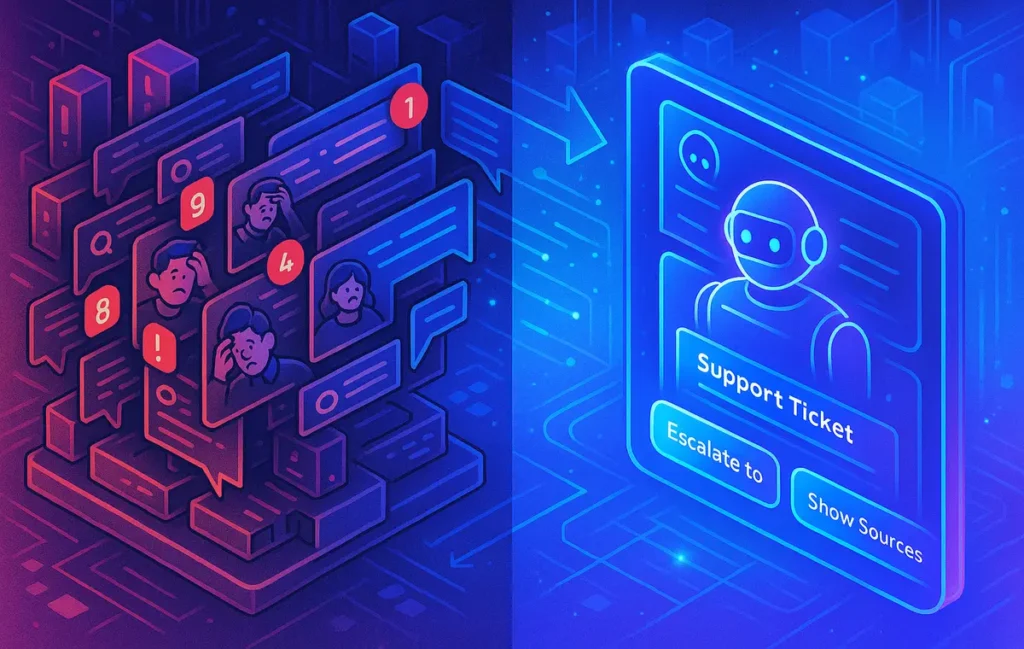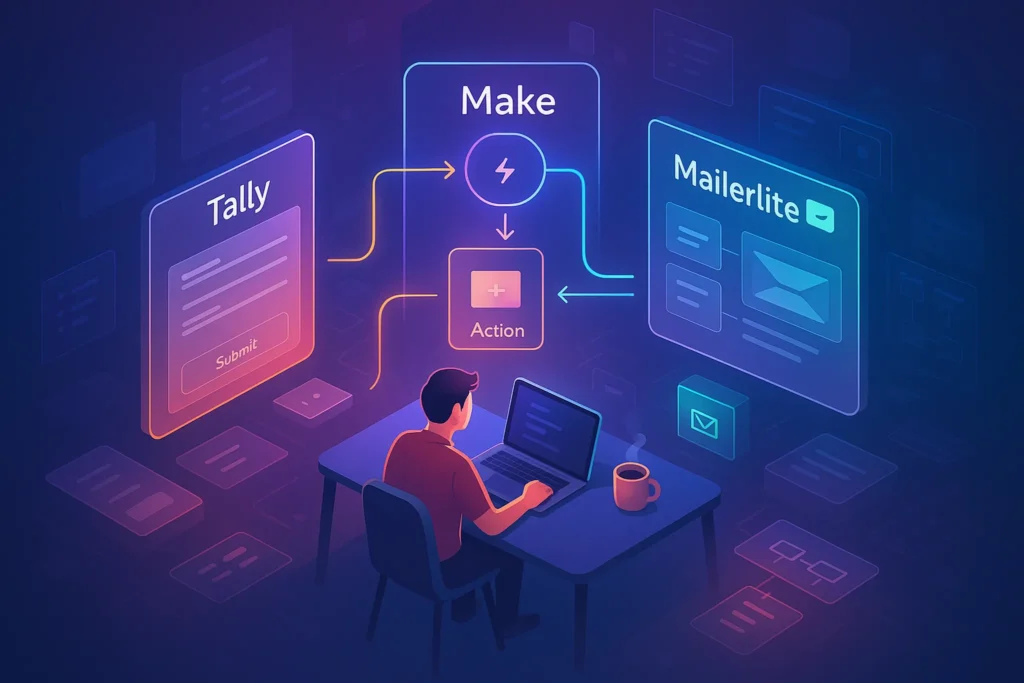🤖 Intro
Most businesses don’t lose customers because they lack empathy—they lose them because they can’t answer fast enough, consistently enough, 24/7. AI agents fix that by handling repetitive conversations, surfacing precise answers, and handing off gracefully when a human should step in. Done right, they improve CX and shrink costs at the same time. Done wrong, they irritate customers and flood your team with escalations.
This guide gives you a step-by-step plan to launch an AI agent that delivers measurable wins in 30–90 days. We’ll map platforms, data sources, handoffs, KPIs, and an ROI model you can plug into your numbers. Along the way, you’ll see natural places to go deeper with NerdChips resources like Automating Customer Support with AI Helpdesks for helpdesk-specific setups, AI Agent Tools for builder options, Best AI-Powered Chatbots for Lead Generation when you want support to feed pipeline, AI Automation for E-commerce Order Processing to wire order data, and AI Task Automation Tools for Remote Teams to connect the agent to internal workflows.
💡 Nerd Tip: Aim for “small, true, fast”—launch a narrow use case that’s genuinely solved end-to-end, then expand.
🧠 Why AI Agents for Support (Now)?
Traditional chatbots answered a handful of scripted questions and collapsed the moment a user strayed off path. Modern AI agents are different: they retrieve knowledge, reason over context, take actions (like checking an order or resetting a password), and recognize when to escalate. The payoff is tangible. If your team resolves a few thousand tickets per month, even modest deflection and handle-time improvements translate into four- and five-figure monthly savings—without sacrificing CSAT.
Crucially, AI agents don’t just cut costs; they standardize quality. Every answer is aligned with your latest policy and tone of voice, which reduces rework and keeps your brand consistent. They also unlock true 24/7 coverage across chat, email, and social, so spikes after a product launch or campaign don’t melt the queue. When you’re ready to wire the agent tightly into a helpdesk, jump to Automating Customer Support with AI Helpdesks—it covers ticket routing and knowledge-sync patterns at a deeper level.
💡 Nerd Tip: Treat AI agents as tier-0.5 support—fast, friendly, and factual—so humans can focus on edge cases and retention-critical moments.
🧩 What Exactly Is an AI Support Agent?
An AI support agent is a system that blends four capabilities:
-
Understanding: parses natural language, intent, and entities.
-
Grounded answers: retrieves the right snippet from your knowledge base, policies, product catalog, or order system and composes a response in your voice.
-
Actions: calls APIs or helpdesk macros to take steps—check order status, issue a return label, update an address.
-
Self-awareness: knows confidence levels and escalates when uncertain.
Under the hood, most production agents use retrieval-augmented generation (RAG) to stay factual, plus guardrails (content filters, policy constraints) to prevent drift. If you’re evaluating builders and frameworks—from out-of-the-box helpdesk AI to composable stacks—bookmark AI Agent Tools for a side-by-side of options and when to choose each.
💡 Nerd Tip: Great agents aren’t “creative.” They’re conservative, grounded, and auditable.
🧭 Step 1 — Identify and Scope Repetitive Support Tasks
Start where volume and clarity intersect: high-frequency, well-documented questions that don’t require account-specific human judgment. Think shipping times, returns policy, warranty, password resets, billing date changes, plan features, or basic troubleshooting. Pull the last 60–90 days of tickets and sort by topic, intent, and data dependency (does it require reading a policy or fetching account data?).
A practical scoping approach is to label three buckets:
-
Answer-only (pure knowledge; no account lookup).
-
Answer + Data (knowledge plus reading an order/account).
-
Answer + Action (knowledge plus API write: refund, replacement, cancellation).
Your launch cohort should include at least one intent from each bucket. That gives you a realistic test of retrieval, basic data reads, and a simple action end-to-end. If your helpdesk already centralizes FAQs and macros, the mapping is straightforward—see Automating Customer Support with AI Helpdesks for patterns to mirror.
💡 Nerd Tip: If an intent ever involves money (refunds, credits), require explicit confirmation before the agent executes.
🧰 Step 2 — Choose the Right AI Agent Platform
You have three broad routes, each with trade-offs:
1) Native Helpdesk AI (Zendesk AI, Intercom Fin, Freshdesk AI).
Fastest to deploy, deep inbox integration, and good guardrails. Best for SMBs that want value in weeks and don’t need bespoke workflows. When you want an at-a-glance market map, jump to Automating Customer Support with AI Helpdesks.
2) No-/Low-Code Agent Builders.
Think workflow-driven tools that expose retrieval, actions, and evaluation without heavy engineering. Great for teams that want more control than native helpdesks but not a full dev effort. Our AI Agent Tools explainer covers current builders and how to wire them to CRMs, ERPs, and data lakes.
3) Composable/Custom (frameworks, SDKs, or LangChain-style stacks).
Maximum control, ideal for complex actions and sensitive data. Requires engineering time, MLOps basics, and ongoing evaluation harnesses.
Platform Fit Snapshot
| Team Profile | Best Fit | Why |
|---|---|---|
| 5–25 agent SMB with Zendesk/Intercom | Native helpdesk AI | Fastest path to value, minimal integration risk |
| E-commerce brand with custom OMS | No-/Low-Code builder | Flexible actions + sane operational load |
| Fintech/Telecom with strict compliance | Composable/custom | Fine-grained control, on-prem/in-VPC options |
💡 Nerd Tip: Pick for the next 12 months, not forever. You can graduate later—launch value now.
🔌 Step 3 — Train and Integrate (Grounded Knowledge + Live Data)
Agents are only as good as their ground truth. Start with a clean knowledge base: policies, help articles, product specs, SOPs, and updated macros. Deduplicate, remove contradictions, and normalize tone. Then define the data plane—the APIs the agent can safely call: order lookup, subscription details, shipment status, device diagnostics, entitlement checks.
Keep the first action boringly safe. Examples:
-
E-commerce: “Where’s my order?” → read from OMS; share ETA and tracking; offer SMS updates. See AI Automation for E-commerce Order Processing to wire Shopify/WooCommerce/OMS flows.
-
SaaS: “I can’t log in” → check status page, confirm email on file, trigger password reset, offer MFA guide.
-
Telecom/IoT: “My device won’t connect” → read serial, suggest step-wise diagnostics, offer human handoff at any step.
Always store conversation transcripts, retrieved snippets, and action logs. You’ll use these for audits and fine-tuning prompts as you expand. If you later want your agent to pre-qualify leads when support chats drift sales-ward, pair it with a narrow conversion flow from Best AI-Powered Chatbots for Lead Generation and set strict handover rules.
💡 Nerd Tip: Add a “Show Sources” toggle in the UI. Customers trust answers that cite your own policy text.
🧑⚖️ Step 4 — Design Escalation Paths Customers Trust
The fastest way to lose goodwill is to trap customers in a loop. Your agent must know its limits and make human help feel one click away. Build an escalation ladder:
-
Self-knowledge: the agent tracks confidence and policy risk flags.
-
Nudge to human: “I might be wrong—want me to bring a specialist?”
-
Golden path handoff: pass the conversation, plus structured context (intent, entities, steps tried, retrieved snippets) into the helpdesk ticket so humans don’t ask customers to repeat themselves.
-
Post-handoff follow-through: the agent stays subscribed to the thread to push forms, links, and summaries as needed.
For omnichannel, you’ll mirror the pattern across chat, email, and social. If your team is fully remote, see AI Task Automation Tools for Remote Teams to coordinate escalations, internal notes, and approvals with Slack/Teams and your ticketing system.
💡 Nerd Tip: Put an “Escalate now” option in the composer. People relax when they see the escape hatch.
📈 Step 5 — Monitor, Learn, and Scale
Instrumentation turns a clever bot into an operational asset. Track:
-
Containment/Deflection Rate: percent of conversations resolved without human help.
-
AHT Delta: minutes saved on agent-assisted tickets.
-
CSAT/Thumbs: sentiment on AI-resolved interactions.
-
Precision: percent of AI answers judged correct by auditors.
-
Escalation Quality: proportion of clean handoffs (complete context, no repeat questions).
Run weekly reviews. Sample transcripts from wins and losses. Fix incorrect retrievals by updating content or changing chunking/embeddings. Promote high-volume patterns to first-class playbooks. When containment stabilizes, add a new intent cohort and one additional safe action.
💡 Nerd Tip: Build a tiny evaluation set—20–50 real tickets with gold-standard answers. Re-run it after each change. Nothing beats a stable eval harness.
⚡ Ready to Scale Support Without Scaling Headcount?
Start with a helpdesk-native AI or a no-code agent builder, wire one safe action, and measure containment weekly. Expand only when precision holds.
🧮 The ROI Model You Can Show Your CFO
Work with your actual numbers. Here’s a simple, transparent model you can copy:
-
Volume: 3,000 tickets/month
-
Blended cost per human ticket: $4 (≈ 12 minutes at $20/hour)
-
Initial containment target: 30% on scoped intents → 900 tickets/month resolved by AI
-
Savings from deflection: 900 × $4 = $3,600/month
-
AHT reduction on remaining tickets: save 2 minutes on 2,100 tickets → 70 hours saved → $1,400/month at $20/hour
-
Platform + compute: ~$1,500/month (varies by vendor and usage)
Net monthly benefit: $3,600 + $1,400 − $1,500 = $3,500
Annualized benefit: $42,000 (before secondary gains like faster first response and improved retention)
Target conservatively. If you scope narrowly and instrument well, you can earn the right to expand.
💡 Nerd Tip: Tie ROI to business moments—launches, holidays, or support spikes. AI coverage shines when queues surge.
🧪 Real-World Use Cases (and How to Wire Them)
🛒 E-commerce (Order, Returns, Exchanges)
Customers ask two questions endlessly: “Where’s my order?” and “How do I return this?” Your agent retrieves policy language verbatim, reads order status from the OMS, and sends tracking links with ETA. For returns, it confirms eligibility, generates a label, and emails the RMA—only escalating if the item crosses policy rules. Expect an immediate drop in queue pressure on weekends and evenings. As you expand, pair this with the SOPs from AI Automation for E-commerce Order Processing to keep inventory and refunds consistent.
🧩 SaaS (Trials, Billing, Onboarding)
The agent explains plan limits contextually, links the exact doc section, and triggers a billing portal link securely. During onboarding, it surfaces the top three tasks new users must complete and checks progress via API (e.g., seat invites sent, first project created). It offers one-click “schedule a call” when it detects frustration. When support overlaps with sales, route warm leads to a mini-flow informed by Best AI-Powered Chatbots for Lead Generation and disclose the switch clearly.
📶 Telecom/Hardware (Diagnostics at Scale)
Your agent asks for model/serial, runs a structured diagnostic tree (“power cycle” → “signal strength” → “firmware version”), and either fixes the issue or packages logs for a human tech. These workflows save minutes in every conversation and prevent redundant steps. Keep the actions list tight at first; expand as your eval set shows consistent precision.
💡 Nerd Tip: When the agent reads account data, mask PII in storage and logs by default. Keep trust a feature, not an afterthought.
🧱 Architecture, Data, and Guardrails
Think in three planes:
-
Knowledge Plane: your canonical facts—the KB, policy docs, product specs, SOPs. Keep them versioned; stale content is the #1 cause of wrong answers.
-
Action Plane: the APIs and automations an agent can call. Start with read-only calls and a few reversible writes.
-
Control Plane: guardrails (PII filters, profanity filters, rate limits), evaluation harness, and observability (what was retrieved, which tool was called, model confidence).
A small governance win: policy labels. Tag snippets with refunds, safety, billing. If an answer references a billing policy, set a higher confidence threshold or require confirmation. This keeps risky flows conservative while letting harmless FAQs run fast.
💡 Nerd Tip: Store retrieval IDs with tickets. If a policy changes, you can trace which answers were affected.
🧱 Launch Checklist (Print-Ready)
-
Define three intents (answer-only, answer+data, answer+action)
-
Clean the KB (merge duplicates, remove contradictions, add examples)
-
Wire one safe API (read-only) and one safe action (reversible)
-
Build gold eval set (20–50 tickets with ideal answers)
-
Design handoff (confidence threshold, human routing, context bundle)
-
Instrument containment, AHT delta, precision, CSAT
-
Ship to 10–20% traffic, review weekly, expand carefully
⚖️ Risks, Failure Modes, and Fixes
Hallucination or over-confident answers.
Fix with stricter retrieval windows, shorter context windows, and source quoting. Prefer “I don’t know” to confident nonsense. Ground everything in your KB.
Customer mistrust.
Disclose the agent clearly, add the “escalate now” button, and use human-reviewed templates for sensitive topics (billing, safety). Customers forgive bots that know when to stop.
Integration complexity.
Start no-code, pick one action, and keep the rest human-assisted. As you learn, graduate to deeper integrations. AI Agent Tools lays out a sensible migration path.
Content sprawl.
Assign KB ownership. Update cadence, review checklist, and a change log. Outdated policy text is the root of most escalations.
Internal resistance.
Position AI as tier-0.5, not a replacement. Show early wins (queue time, AHT) and reroute freed time to proactive retention. Culture follows incentives.
💡 Nerd Tip: Audit 10 random AI-resolved chats weekly. Celebrate one great transcript in team standup. Positive examples accelerate adoption.
📬 Want More Smart AI Ops Playbooks?
Join our free newsletter for weekly deep dives on AI agents, no-code automations, and CX optimization—field-tested by NerdChips and delivered to your inbox.
🔐 100% privacy. No noise. Just value-packed playbooks from NerdChips.
🧠 Nerd Verdict
Automating support with AI agents isn’t about replacing people—it’s about raising the floor of every interaction. The winning playbook is simple: start narrow, ground answers in your own knowledge, give customers a visible escape hatch, and instrument everything. As precision stabilizes, your agent becomes a durable asset: queues shrink, humans focus on meaningful moments, and CX stays consistently on brand. At NerdChips we’ve seen that teams who treat AI as tier-0.5 plus orchestration build trust faster and bank the savings sooner.
❓ FAQ: Nerds Ask, We Answer
💬 Would You Bite?
If you were launching this month, where would you start: FAQ automation for instant wins or order tracking for measurable deflection and happier post-purchase customers?
Crafted by NerdChips for creators and teams who want their best ideas to travel the world.



